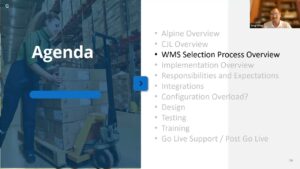Distribution Network Optimization: A Strategic Approach
By Phil Quartel
Optimizing a distribution network is a key pillar in developing a sustainable and scalable supply chain strategy. It’s a complex process that goes beyond analyzing transportation costs or conducting a center of gravity analysis. A robust approach integrates factors such as operating costs, service levels, risk mitigation, labor availability, transport accessibility, facility operations, inventory management, and the utilization of existing assets. It must also align with the company’s overarching business goals and growth strategy.
To achieve a truly optimized distribution network, businesses must engage leadership and key stakeholders, both internally and externally. This collaboration ensures that the future distribution network is not only flexible and agile but also capable of addressing challenges such as geopolitical shifts and supply chain disruptions. By prioritizing these areas, companies can develop a migration plan that outlines the transition from the current state to the optimized future network while keeping an eye on cost efficiency and customer satisfaction.
What is Distribution Network Optimization
Distribution Network Optimization is the process of designing, configuring, and continuously improving a company’s distribution network to maximize efficiency, reduce costs, and meet customer service requirements. This process involves strategically positioning facilities such as distribution centers (DCs), warehouses, and cross-docks, while optimizing the flow of goods and information across the supply chain.
Key objectives of distribution network optimization include:
- Cost Efficiency: Minimizing transportation, warehousing, and inventory holding costs without compromising service quality.
- Service Level Improvements: Ensuring faster delivery times, improved order accuracy, and better fulfillment options for customers.
- Inventory Management: Streamlining inventory levels across locations to minimize overstocking or stockouts while balancing demand.
- Facility Location Optimization: Deciding on the best locations for distribution centers or warehouses based on factors like proximity to customers, transportation routes, labor availability, and market demand.
- Transportation Optimization: Streamlining transportation routes, reducing shipping distances, consolidating shipments, and optimizing modes of transport to reduce costs and increase efficiency.
- Scalability and Flexibility: Designing the distribution network to adapt to future growth, changes in demand, or disruptions like geopolitical events or supply chain bottlenecks.
Key Considerations for Distribution Network Optimization
As businesses redefine their supply chain, product flow decisions must be made to determine how goods and information will move from vendors or manufacturing sites to customers. Key questions to address include:
- Supply Points: Are changes needed to accommodate a new distribution center (DC)? With shifting geopolitical landscapes and climate concerns, the supply chain strategy must consider alternate vendors that may offer better quality, reduced transportation costs, and faster transit times.
- Inventory Strategy: Defining how inventory will be deployed across the distribution network is critical. This includes decisions on the types of SKUs, slow-moving versus core products, and how to manage different channels like retail and direct-to-consumer.
- Product Flow: Determining how products will move from supply points to multiple facilities is crucial. Options such as cross-docking, break-bulk centers, and even direct shipping to customers must be considered.
- Inbound Transportation: How will splitting inbound shipments between multiple distribution centers impact vendor order minimums, freight costs, and transportation efficiency? It’s vital to develop a clear strategy and rule set for managing these changes.
- Systems Requirements: Optimizing the distribution network often requires upgrades to
- systems such as order management, inventory management, and transportation management. Ensuring these systems can support new strategic requirements is key to seamless operations.
Fulfilling the Customer Experience Through Distribution Network Optimization
While optimizing inbound product flow is essential, customer-facing distribution operations also need careful consideration. As infrastructure evolves, businesses must balance service levels, SKU characteristics, transportation modes, and customer locations to maintain efficiency and reduce costs. An optimized distribution network ensures the right product is delivered at the right time, enhancing customer satisfaction while minimizing operational expenses.
Key areas to address include:
- SKU Rationalization: Which SKUs will be carried in each facility? Strategic decisions around inventory stocking and regional demand can impact safety stock, carrying costs, and operational efficiency.
- Order Fulfillment: How will customer orders be fulfilled across the distribution network? Whether orders are processed from one or multiple locations can influence demand planning, inventory policies, and systems capabilities.
- Seasonality and Demand Fluctuations: Peak seasons require flexible storage solutions
- and operational strategies. Offsite storage may be a viable option, but businesses must also plan for the added complexities that come with value-added services during busy times.
- Systems Integration: Ensuring that systems can support new processes and fulfillment requirements is crucial for a smooth transition to an optimized network. Any gaps in current capabilities must be addressed to align systems with the strategic recommendations.
Components of Distribution Network Optimization
There are four main components of optimizing your network:
- Data Analysis: Analyzing data on customer locations, shipping costs, demand patterns, and product flow to identify areas for improvement.
- Network Design: Evaluating the current network structure to determine the best configuration of distribution centers, warehouses, and transportation routes.
- Technology Integration: Utilizing advanced systems like Warehouse Management Systems (WMS), Transportation Management Systems (TMS), and Inventory
- Management Systems (IMS) to streamline processes and enhance visibility across the network.
- Scenario Modeling: Using simulations to test different configurations and strategies to identify the most efficient network design.
Distribution Network Optimization In Summary
Distribution network optimization is not just about solving logistical challenges—it’s a transformative approach that affects every facet of the business, from vendor relations to
customer service. Engaging stakeholders across the organization and integrating their input into the strategy ensures that the future supply chain is both efficient and aligned with long-term business goals. Through a comprehensive and collaborative approach, businesses can unlock the full potential of their supply chain, achieving operational excellence and customer satisfaction at the lowest total cost to serve. Contact Alpine to discuss how we can help ensure that your distribution network will be sustainable as your needs change and grow.













